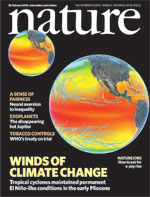
Intense hurricane activity millions of years ago may have caused and sustained warmer climate conditions, new research suggests
A question central to research on global warming is how warmer temperatures caused by increased greenhouse gases could influence climate. Probing the past for clues about this potential effect, MIT and Yale climate scientists examined the Pliocene period, which began five million years ago and which some consider to be a potential analog to modern greenhouse conditions. They found that hurricanes influenced by weakened atmospheric circulation — possibly related to high levels of carbon dioxide — contributed to very warm temperatures in the Pacific Ocean, which in turn led to more frequent and intense hurricanes. The research indicates that Earth's climate may have multiple states based on this feedback cycle, meaning that the climate could change qualitatively in response to the effects of global warming.
Although scientists know that the early Pliocene had carbon dioxide concentrations similar to those of today, it has remained a mystery what caused the high levels of greenhouse gas and how the Pliocene's warm conditions, including an extensive warm pool in the Pacific Ocean and temperatures that were roughly 4 degrees C higher than today's, were maintained.
In a paper published Feb. 25 in Nature, Kerry Emanuel, the Breene M. Kerr Professor of Atmospheric Science in the Department of Earth, Atmospheric and Planetary Science, and two colleagues from Yale University's Department of Geology and Geophysics suggest that a positive feedback between tropical cyclones — commonly called hurricanes and typhoons — and the circulation in the Pacific could have been the mechanism that enabled the Pliocene's warm climate.
The Pliocene ended around three million years ago with the onset of large ice sheets in the Northern Hemisphere. There has been a slow reduction in carbon dioxide levels in the atmosphere for about 15 million years, and it is thought that the start of the glacial cycles was the climate's response once those levels reached a certain threshold, according to co-author Chris Brierley. While that level remains unknown, this research indicates that by increasing carbon dioxide levels, humans could reach the threshold that would induce a Pliocene-like climate.

